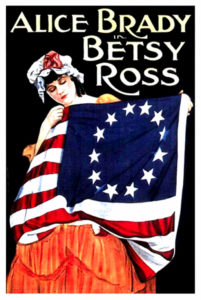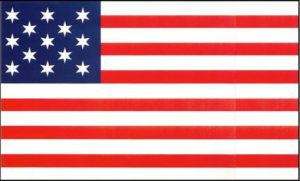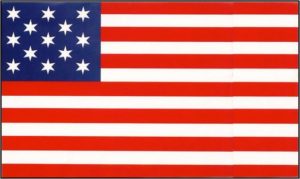Jul
5
Origins of the First Official American Flag
“The flag, like the Revolution it represents, was the work of many hands.” — Marla R. Miller, Betsy Ross and the Making of America (2010)
When most Americans think of the first American flag, they think of upholsterer/seamstress Elizabeth Griscom “Betsy” Ross. The design attributed to her, with a circle of 13 stars within the blue field, has become “a symbol of the American Revolution and the young Republic.”

The folklore — based primarily on a story propagated by Ross’s descendants several decades later — has her accepting the job of manufacturing the first flag according to specs by a small committee of Founding Fathers (whose identities differ according to the version of the tale) in June 1776. There are problematic issues with the story, but even if one accepts it, Ross’s biographer says, “Betsy Ross was merely one of several flag makers in Philadelphia, and her only contribution to the design was [that she] cut the easier 5-pointed stars [rather than the indicated six-pointed stars].”
“Any flag maker in Philadelphia could have sewn the first American flag. Even according to Canby, there were other variations of the flag being made at the same time Ross was sewing the design that would carry her name. If true, there may not be one ‘first’ flag, but many.”
While the original manufacturer of the first American flag — if one can truly point to one design as “first” — is unknown and may be a mystery with no possible answer, we do have a better idea who actually designed the first “official” national flag of the United States. The strongest case is in favor of Francis Hopkinson, an author, poet, composer, merchant, lawyer, and distinguished civil servant.
Hopkinson served as a New Jersey delegate to the Continental Congress and was a signer of the Declaration of Independence. He was appointed Judge of the Admiralty Court of Pennsylvania in 1779, a position he held for ten years. Meanwhile, Hopkinson had become a member of the Continental Marine Committee in 1776. By the time the Continental Congress resolved to adopt the “Stars and Stripes” as the first official national flag of the U.S.A. on June 14, 1777, Hopkinson was Chairman of the Navy Board under the Continental Marine Committee, which submitted said Flag Resolution.
In addition to the above achievements, Hopkinson also dabbled in artistic design and had designed (with Pierre Eugene du Simitiere) the Great Seal of New Jersey. So, it was natural that he would work on the design of the new American flag, the Great Seal of the United States, and other ornaments, devices, seals, etc. In a May 1780 letter to the Board of Admiralty, Hopkinson asserted that he had designed “the flag of the United States of America” (among other things) and humbly requested “a Quarter Cask of the public wine” as compensation. While waiting, he sent a new request two months later to the Board of Treasury, requesting £2700 (~$3,985) for various “drawings and devices” and designing the “Naval flag of the United States”. (He didn’t mention the American flag this time.) When asked, he followed up with an itemized bill, including a mere £9 for the naval flag.

After many bureaucratic arguments and delays from the Board of Treasury and Congress, the board ultimately (late 1781?) decided that a) Hopkinson couldn’t claim full recompense due to his only being one of multiple contributors, and b) he was already sufficiently well-paid and should be willing to provide such extra services without extra compensation. Technically, however, there is no record of any committee of the Continental Congress being assigned to design the national flag or naval flag. The only evidence for Hopkinson collaborating with others on designs is for the work on the Great Seal.
Congress denied Hopkinson payment. (Given how tight money was for the revolutionaries, I’m not surprised.) Regardless, his political adversaries never denied that he designed “the flag of the United States of America”, and the journals of the Continental Congress support this.
There are, in fact, no extant sketches of Hopkinson’s flag designs. What we have are his rough sketches of the Great Seal of the United States and his design for the Admiralty Board Seal, which incorporate elements of his flag designs.

“The rough sketch of his second Great Seal proposal has 7 white stripes and 6 red stripes. The impression of Hopkinson’s Admiralty Board Seal has a chevron with 7 red stripes and 6 white stripes. The Great Seal reflects Hopkinson’s design for a governmental flag and the Admiralty Board Seal reflects Hopkinson’s design for a naval flag. The predominance of red stripes made the naval flag more visible against the sky on a ship at sea. Both flags were intended to have 13 stripes. Because the original stars used in the Great Seal had six points, Hopkinson’s U.S. flag might also have intended the use of 6-pointed stars. This is bolstered by his original sketch for the Great Seal that featured a U.S. flag with six-pointed asterisks for stars.” (Wikipedia)
However, it was the design for the Naval flag, with its red outer stripes, that Congress chose for the national flag.
Hopkinson was a member of the Pennsylvania Convention which ratified the United States Constitution in 1789, writing several effective articles that helped push it through. He was then nominated by President Washington and confirmed by the Senate to the United States District Court of Pennsylvania in September 1789. Hopkinson remained on the court until his death by apoplectic seizure on May 9, 1791.















